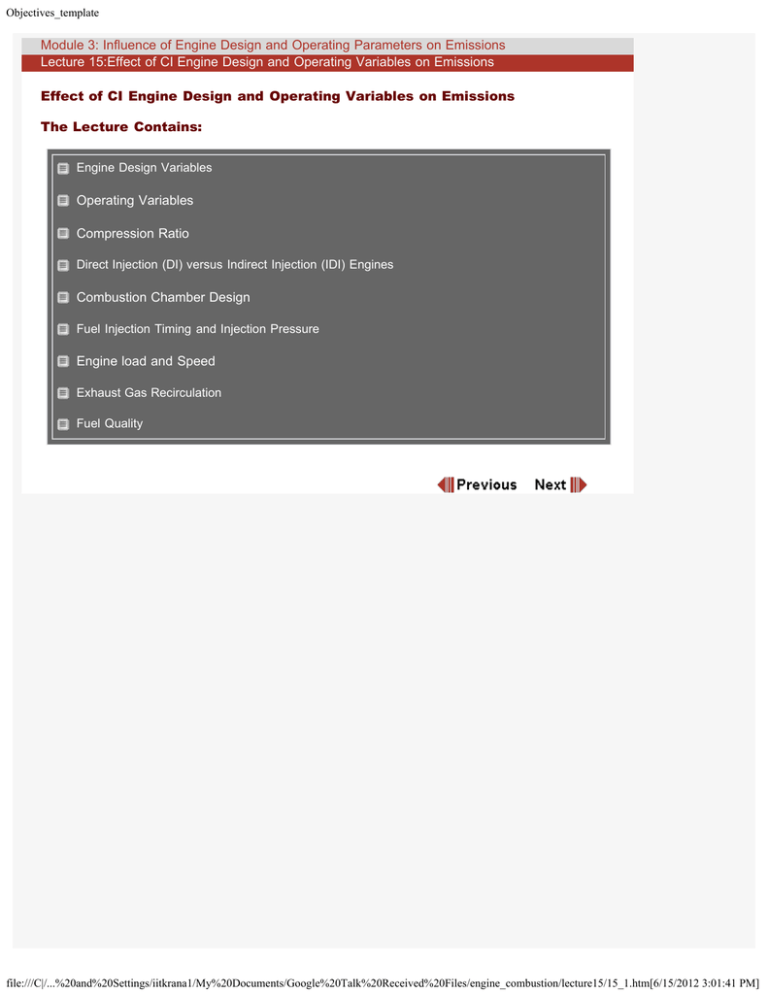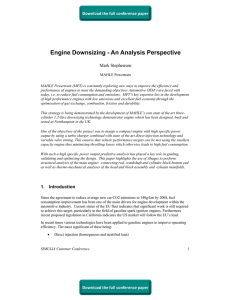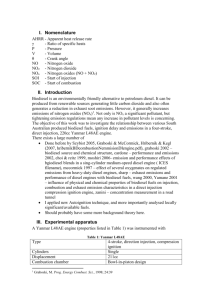Influence of Engine Design and Operating Parameters on
advertisement

Objectives_template Module 3: Influence of Engine Design and Operating Parameters on Emissions Lecture 15:Effect of CI Engine Design and Operating Variables on Emissions Effect of CI Engine Design and Operating Variables on Emissions The Lecture Contains: Engine Design Variables Operating Variables Compression Ratio Direct Injection (DI) versus Indirect Injection (IDI) Engines Combustion Chamber Design Fuel Injection Timing and Injection Pressure Engine load and Speed Exhaust Gas Recirculation Fuel Quality file:///C|/...%20and%20Settings/iitkrana1/My%20Documents/Google%20Talk%20Received%20Files/engine_combustion/lecture15/15_1.htm[6/15/2012 3:01:41 PM] Objectives_template Module 3: Influence of Engine Design and Operating Parameters on Emissions Lecture 15:Effect of CI Engine Design and Operating Variables on Emissions CI Engine Design and Operating Variables and Emissions Important diesel engine variables that influence emissions are: Engine Design Variables Compression ratio Combustion chamber type Combustion chamber design Injection system: injection pressure and timing, nozzle holes, nozzle sac volume Operating Variables: EGR Engine speed Engine load Fuel quality Compression Ratio In the diesel engines the minimum compression ratio that can be used is governed by the ease of engine cold starting ability. For the high speed direct injection engines CR of around 16 to 17.5:1 is used. The turbocharged heavy duty engines employ CR in the range of 13 to 14:1. Cold starting requirements prevents further reduction in the compression ratio. Use of higher compression ratio results in a shorter ignition delay period. A shorter delay would result in less ‘overmixing' of fuel and air and hence, lower HC emissions. Further, the higher combustion temperatures obtained at a higher compression ratios tend to increase oxidation of the unburned HC. At a low compression ratio, a longer delay increases the fraction of fuel burned during the premixed phase resulting in higher peak pressures and temperatures which cause an increase in NO x formation. On the other hand, increase in compression ratio due to higher combustion temperatures would tend to increase formation of NOx. If the ignition delay is too long the combustion may begin in the expansion stroke reducing combustion pressure and temperature. Too long an ignition delay leads to lower NOx emissions along with poor fuel efficiency. Use of a low compression ratio results in too long a delay during engine warm up under cold conditions, and it causes high emissions of unburned fuel which due to its appearance is called ‘white smoke'. A high compression ratio leading to high combustion temperatures would increase soot formation while on the other hand it increases soot oxidation. For obtaining low particulate and NOx emissions simultaneously, an optimum compression ratio is to be used. file:///C|/...%20and%20Settings/iitkrana1/My%20Documents/Google%20Talk%20Received%20Files/engine_combustion/lecture15/15_2.htm[6/15/2012 3:01:41 PM] Objectives_template Module 3:Influence of Engine Design and Operating Parameters on Emissions Lecture 15:Effect of CI Engine Design and Operating Variables on Emissions Direct Injection (DI) versus Indirect Injection (IDI) Engines The DI and IDI engines have been in use for many years. The IDI engines were mostly employed in high speed small engine applications. Now, after the development of high speed direct injection (HSDI) engines the IDI engines due to their poor fuel economy are being phased out of production. The combustion in IDI engines takes place in two stages; a rich mixture burns in the pre-chamber where all the fuel is injected and the partially burned rich fuel- air mixture from the pre-chamber is transported to the main chamber where due to presence of excess air combustion is completed. The jet of high pressurepartially burned gases from the pre-chamber enters the main chamber generating high turbulence that causes rapid mixing and most of the fuel burns as lean mixture. Figure 3.4 Comparison of NO x concentrations in DI andDI diesel engines A comparison of NO x emissions with DI and IDI engines is shown on Fig. 3.4. At light loads, most of NO may form in the pre-chamber. But, at higher loads additional NO formation would occur in the main chamber. Although temperatures are higher in the pre-chamber than the main chamber, but except at light loads mixture is overall rich and hence, the lower formation of NO. In the DI engines, at the end of premixed combustion higher peak pressures and temperatures are obtained compared to the IDI engines and NO is formed in near stoichiometric mixtures during mixing controlled phase and post combustion gases. Due to these factors overall, the indirect injection engines emit lower NOx. In the DI engines due to low turbulence levels some of CO formed in the rich spray regions may not find the required oxygen for complete combustion while thetemperatures are still high. It results in .higher CO emissions than the IDI engines even though more excess air is present in the DI engines. file:///C|/...%20and%20Settings/iitkrana1/My%20Documents/Google%20Talk%20Received%20Files/engine_combustion/lecture15/15_3.htm[6/15/2012 3:01:41 PM] Objectives_template Module 3:Influence of Engine Design and Operating Parameters on Emissions Lecture 15:Effect of CI Engine Design and Operating Variables on Emissions Combustion Chamber Design a. Dead Volumes Air in the combustion chamber is contained in several different volumes like piston bowl, top land crevice, piston – cylinder head clearance, valve recess and head gasket clearance. Typical distribution of clearance volume at tdc among different components for a DI diesel engine is shown in Table 3.2. The piston bowl in DI diesel engines contains slightly more than 50% of total clearance volume at tdc. The air contained in top land crevice, head gasket clearance and valve recess is nearly 15 % and is poorly utilized during combustion. Even the air contained in the volume between piston crown and cylinder head at tdc is poorly utilized. Piston-cylinder crevice volumes store morethan proportionate air due to lower temperature in the crevice region compared to the temperature of air in the cylinder. A reduction in crevice volume therefore, increases air utilization. Similarly, a lower clearance between piston and cylinder head increases air utilization and reduces the possibility of fuel entering the crevices. Reduction in ‘poor air utilization' volumes results in lower particulate emission and fuel consumption.. Table 3.2 Volume Distribution of Combustion Chamber at TDC Piston bowl 55% Piston – Cylinder head 30% Clearance Valve recess 6% Top land crevice 7% Head gasket 2% b. Multi-Valves and Air Motion Use of multiple valves (3 or 4) per cylinder increases flow area and hence, the volumetric efficiency of the engine. Four valves per cylinder are now common in gasoline engines. In the direct injection diesel engines use of four valves enables a centralized location of injector and combustion bowl in the piston. The injector can be placed more centrally and vertically. Typical PM-NO x characteristics for 4- and 2valve per cylinder passenger car diesel engines are compared on Fig. 3.5.With two valves designs, the injector is always offset and inclined. Injector inclination of 20 and 10 degrees from vertical has been observed to give an increase of about 25 and 5 %, respectively in PM emissions due to poor fuel distribution in the cylinder compared to a vertically located injector. Reduction of up to 4 to 7 % in specific fuel consumption is also obtained at the same NO x emission level in a multi-valve engine with centrally placed combustion bowl and injector. file:///C|/...%20and%20Settings/iitkrana1/My%20Documents/Google%20Talk%20Received%20Files/engine_combustion/lecture15/15_4.htm[6/15/2012 3:01:41 PM] Objectives_template PM – NO x trade-off for two valve and four-valve Figure 3.5 passenger car DI diesel engines. A centrally placed combustion bowl has lower swirl requirements and results in more equal fuel distribution and availability of equal air to each spray for mixing. In four-valve engines, symmetrical air motion in the piston bowl and equal fuel distribution between different sprays lead to optimum mixture formation and combustion with very low smoke levels. Use of lower air swirl in 4-valve engines compared to 2-valve engines for the same PM and NOx emission levels, results in reduction of fuel -air ‘overmixing' during premixed phase of combustion. As ‘overmixing' of fuel is an important source of HC emissions, lower HC emissions in 4-valve engines are obtained. file:///C|/...%20and%20Settings/iitkrana1/My%20Documents/Google%20Talk%20Received%20Files/engine_combustion/lecture15/15_4.htm[6/15/2012 3:01:41 PM] Objectives_template Module 3:Influence of Engine Design and Operating Parameters on Emissions Lecture 15:Effect of CI Engine Design and Operating Variables on Emissions Fuel Injection Timing and Injection Pressure Effect of fuel injection timing on NO x emissions from CI engines is quite similar to that of spark timing in SI engines. Typical effect of injection timing on NO x , HC, smoke emissions and fuel consumption is shown on Fig 3.6. With retarded injection timing, as expected the NO x emissions decrease sharply. On the other hand an increase in smoke results with retarded injection timing If the injection timing is retarded too much, HC emissions in naturally aspirated engines also may increase sharply. An increase in injection pressure results in higher NO x and HC, but yields lower smoke and PM emissions. Effect of injection pressure on PM emissions is shown on Fig. 3.7. With high injection pressures of 1500 bars and higher, small nozzle orifices of about 0.15 mm dia. are used. The high injection pressure and small nozzle holes give very good fuel atomization with very small fuel droplets which vaporize rapidly resulting in low soot emissions Figure 3.6 Effect of injection timing on emissions and fuel economy for a heavy-duty diesel engine. file:///C|/...%20and%20Settings/iitkrana1/My%20Documents/Google%20Talk%20Received%20Files/engine_combustion/lecture15/15_5.htm[6/15/2012 3:01:42 PM] Objectives_template Figure 3.7 Effect of Injection pressure on PM emissions for a heavy duty diesel engine. file:///C|/...%20and%20Settings/iitkrana1/My%20Documents/Google%20Talk%20Received%20Files/engine_combustion/lecture15/15_5.htm[6/15/2012 3:01:42 PM] Objectives_template Module 3:Influence of Engine Design and Operating Parameters on Emissions Lecture 15:Effect of CI Engine Design and Operating Variables on Emissions Engine load and Speed For developing higher power more fuel is injected in the diesel engine thereby reducing excess air, which results in higher combustion and exhaust temperatures. A typical dependence of NO on air-fuel ratio i.e., engine load has been shown in Fig. 3.4. Dependence of smoke on overall fuel-air ratio for a direct injection diesel engine is shown on Fig. 3.8. Figure 3.8 Effect of air-fuel ratio and engine load on soot emissions for a DI diesel engine With increase in engine load (increase in fuel-air ratio); NO X and soot emissions increase. With increase in engine load as the combustion temperatures increase and oxidation environment for CO is more favourable, CO emissions decrease until excess air reduces to about 30 percent . With further increase in load and fuel-air ratio, CO emissions start increasing again and rise sharply as still more fuel is injected to increase engine power output. At maximum load, NO x , CO and soot are also at their maximum level. HC however, reduce with increase in engine load as higher gas temperature lead to an increase in the oxidation rates. Engine brake thermal efficiency increases with engine load because the ratio of friction to brake power goes down. Interaction among these factors results in lowest value of brake specific fuel consumption (BSFC), and optimum value of brake specific nitrogen oxides (BSNOx ) and particulate emissions at an intermediate load. The variable speed engines are designed to give lowest fuel consumption at about 2/3rd of maximum file:///C|/...%20and%20Settings/iitkrana1/My%20Documents/Google%20Talk%20Received%20Files/engine_combustion/lecture15/15_6.htm[6/15/2012 3:01:42 PM] Objectives_template speed at which heavy duty engines are normally operated. In turbocharged engines, the boost pressure is reduced at low engine speeds resulting in higher fuel-air ratio. At high speeds pumping losses increase and cooling decreases. The coolant and residual gases are hotter as the speed increases. Both these factors increase NO x at high engine speeds. The HC and PM have an optimum at an intermediate speed because time available for oxidation decreases at the higher engine speeds. file:///C|/...%20and%20Settings/iitkrana1/My%20Documents/Google%20Talk%20Received%20Files/engine_combustion/lecture15/15_6.htm[6/15/2012 3:01:42 PM] Objectives_template Module 3:Influence of Engine Design and Operating Parameters on Emissions Lecture 15:Effect of CI Engine Design and Operating Variables on Emissions Exhaust Gas Recirculation The role of EGR is to act as inert diluents and heat sink that reduces the oxygen concentration during combustion and lowers the combustion temperatures. The flame temperatures are reduced as a result of EGR. The NO x formation being an exponential function of temperature, even a small reduction in flame temperature has a large effect on NO x formation. Increase in heat capacity of charge caused by EGR has generally been thought to result in reduction of NOx emissions from SI engines. However, in the diesel engines, EGR can affect NO x reduction in three possible ways. These effects are: Dilution effect: It is the reduction in inlet charge oxygen concentration Thermal effect: It is the increase in inlet charge heat capacity, and Chemical effect: Modification in combustion process as a result of dissociation of CO 2 and water vapour The dilution effect (reduction in inlet oxygen) is the dominant effect in case of diesel engines. The chemical and thermal effects are relatively small. Figure 3.9 Typical effect of effect of EGR on NOx, HC and fuel economy for a turbocharged, intercooled passenger car DI diesel engine Typical effect of EGR on NO x , HC and CO emissions for a turbocharged passenger car DI diesel engine is shown on Fig 3.9 . At around 10% EGR, 50% reduction in NO x is obtained with little change in CO and HC. As the EGR rate is increased beyond 15 %, NO x decreases further, but CO, smoke and HC are increased. The excess air declines with increase in EGR causing sharp increase in smoke and loss in fuel economy. file:///C|/...%20and%20Settings/iitkrana1/My%20Documents/Google%20Talk%20Received%20Files/engine_combustion/lecture15/15_7.htm[6/15/2012 3:01:42 PM] Objectives_template The effect of EGR at the same rate (% of intake air) on diesel NO x is lower compared to SI engine as the exhaust gas in diesel engine contains smaller amounts of tri-atomic gas CO 2 .. Exhaust gas recirculation has been used on diesel passenger cars since mid-1990s to reduce NO x emissions. This is being applied now on more and more diesel engines as the emission standards are being tightened. file:///C|/...%20and%20Settings/iitkrana1/My%20Documents/Google%20Talk%20Received%20Files/engine_combustion/lecture15/15_7.htm[6/15/2012 3:01:42 PM] Objectives_template Module 3:Influence of Engine Design and Operating Parameters on Emissions Lecture 15:Effect of CI Engine Design and Operating Variables on Emissions Fuel Quality For petroleum fuels many of the properties such as hydrocarbon composition, natural cetane number, volatility, viscosity and density are interdependent. As the fuel density decreases the fuel contains more of paraffinic hydrocarbons, which results generally in higher cetane number and fuel volatility and lower viscosity. So, the effect of change in one fuel quality parameter on emissions may be some times the result of several interactions. A high fuel cetane number improves cold starting and results in faster warm-up thus reducing cold engine HC emissions. As an increase in the cetane number reduces ignition delay it results in lowering of HC and NO x emissions. On the other hand, with higher fuel volatility a larger lean flame out ‘overmixing' region may result and due to faster fuel evaporation the fraction of fuel burned during premixed combustion is also higher. Therefore, an increase in NO x as well as HC may be observed with more volatile diesel fuels. The fuel sulphur increases sulphates in PM emissions increasing the particulate mass Summary The effect of various design and operating variables on DI diesel engine performance and emissions are summarized in Table 3.3. Table 3.3 Emission Trends with Engine Design and Operating Variables for Diesel Engines Parameter BSFC BSNOx BSHC PM Engine design variables Compression ratio Stroke/Bore ratio Crevice volume Swirl Valve number Fuel injection variables Injection pressure Retarded injection timing Sac volume Number of holes (size smaller) Pilot injection Eccentricity of Injector Operating parameters file:///C|/...%20and%20Settings/iitkrana1/My%20Documents/Google%20Talk%20Received%20Files/engine_combustion/lecture15/15_8.htm[6/15/2012 3:01:42 PM] Objectives_template Engine speed Engine load Coolant temperature Fuel cetane number Fuel sulphur content Fuel volatility file:///C|/...%20and%20Settings/iitkrana1/My%20Documents/Google%20Talk%20Received%20Files/engine_combustion/lecture15/15_8.htm[6/15/2012 3:01:42 PM] Objectives_template Module 3:Influence of Engine Design and Operating Parameters on Emissions Questions (3.1) Calculate average molar specific heat of products of complete combustion of C 8H 18 with fuel air equivalence ratio, =1.0 (typical of SI engine) and = 0.7 (typical of CI engine atfull load). EGR is used to control NO formation in IC engines. Using this information explain why EGR is more effective in SI than in the CI engines? Show qualitatively on the same graph the trends in percent reduction in NO with EGR rate for typical SI and CI engine operation. Molar specific heat for the gases; N 2 = 33.75, O2 = 35.59, CO2 = 55.37, H 2O = 44.94 kJ/kmol.K. (3.2) For a SI engine having the same swept volume its design is changed from square (bore= stroke) to over square ( bore> stroke) configuration. Discus how will it affect the engine emissions of HC, CO and NOx. An over square engine can be made to operate at a higher engine speed. Howl an increase in speed would influence emissions? In all the cases imep is kept nearly the same. (3.3) Explain the trends in NO formation observed for DI and IDI engines shown on Fig. 3.4. (3.4) Discuss why advancement of injection timing in a CI engine results in an increase in NOx and HC emissions but in lower soot emissions. (3.5) Following Table 3.3 show the trends on the effect of inlet air humidity, boost pressure, valve flow area, mean piston speed, EGR and oxygen enrichment of air in the cylinder file:///C|/...%20and%20Settings/iitkrana1/My%20Documents/Google%20Talk%20Received%20Files/engine_combustion/lecture15/15_9.htm[6/15/2012 3:01:42 PM]



